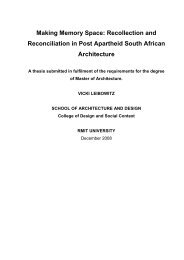Objects in Flux - RMIT Research Repository - RMIT University
Objects in Flux - RMIT Research Repository - RMIT University
Objects in Flux - RMIT Research Repository - RMIT University
You also want an ePaper? Increase the reach of your titles
YUMPU automatically turns print PDFs into web optimized ePapers that Google loves.
<strong>Objects</strong> <strong>in</strong> <strong>Flux</strong><br />
[Figure 6-9]<br />
Apple iPod runn<strong>in</strong>g iPodL<strong>in</strong>ux, 2008.<br />
Image is author’s own.<br />
14/ This narrative was pieced to-<br />
gether from numerous posts on the<br />
iPodL<strong>in</strong>ux forum, http://ipodl<strong>in</strong>ux.<br />
org/forums/ accessed 21 May 2008,<br />
and an account written by Nils Sch-<br />
neider available through the Internet<br />
Archive, http://web.archive.org/<br />
web/20070601200428/http://www.<br />
ipodl<strong>in</strong>ux.org/stories/piezo/<strong>in</strong>dex.html<br />
accessed 21 May 2008.<br />
118<br />
iPodL<strong>in</strong>ux development team. When run on<br />
the iPod, the code caused the iPod’s piezoelectric<br />
transducer (the device that produces<br />
the audible click<strong>in</strong>g noise when the iPod’s<br />
buttons are pressed) to make a ‘squeak<strong>in</strong>g’<br />
sound. Schneider discovered that by vary<strong>in</strong>g<br />
some of the code’s parameters he was able to<br />
produce a range of different sounds. It occurred<br />
to Schneider that he may be able to use these<br />
sounds to transfer data. Select<strong>in</strong>g two dist<strong>in</strong>ctly<br />
different sounds, Schneider wrote a program<br />
that would translate the b<strong>in</strong>ary data stored <strong>in</strong><br />
the iPod’s memory <strong>in</strong>to a series of clicks and beeps that could be<br />
output through the transducer. Then, with the help of fellow developer<br />
David Carne (screen name Busonerd), he constructed the signal<br />
analysis software needed to convert the audio back <strong>in</strong>to b<strong>in</strong>ary data.<br />
It took eight hours to dump the entire 64kb of data from the iPod’s<br />
flash memory out the piezoelectric transducer. Schneider constructed<br />
a small record<strong>in</strong>g studio from a cardboard box <strong>in</strong> order to limit<br />
external noise. The resultant record<strong>in</strong>g was then <strong>in</strong>put <strong>in</strong>to the signal<br />
analysis software. After a number of failed attempts, Schneider succeeded<br />
<strong>in</strong> reconstruct<strong>in</strong>g the data from the iPod’s memory. Us<strong>in</strong>g this<br />
data the iPodL<strong>in</strong>ux development team were able to reverse – eng<strong>in</strong>eer<br />
the bootloader code and successfully <strong>in</strong>stall L<strong>in</strong>ux on the fourth<br />
generation iPod. 14<br />
As de Certeau claims <strong>in</strong> The Practice of Everyday Life: ‘there is a<br />
certa<strong>in</strong> art of plac<strong>in</strong>g one’s blows, a pleasure <strong>in</strong> gett<strong>in</strong>g around the<br />
rules of a constra<strong>in</strong><strong>in</strong>g space’ (1984, p. 18). This ‘pleasure’ is clearly<br />
evident <strong>in</strong> Nils Schneider’s actions. For Schneider, and the other<br />
members of the iPodL<strong>in</strong>ux development team, the iPod is a place<br />
of experimentation where iPod use becomes a highly complex form<br />
of play, an exploration of ‘the limits of what is possible’ (Stallman,<br />
2002). iPodL<strong>in</strong>ux team member Bernard Leach expla<strong>in</strong>s that the<br />
project is partly for fun but it also has a more serious purpose: ‘It<br />
changes the iPod from a consumer device, where the manufacturer<br />
sets the rules about what it will and won’t do, <strong>in</strong>to a general purpose<br />
device’ (Knight, 2005).
















